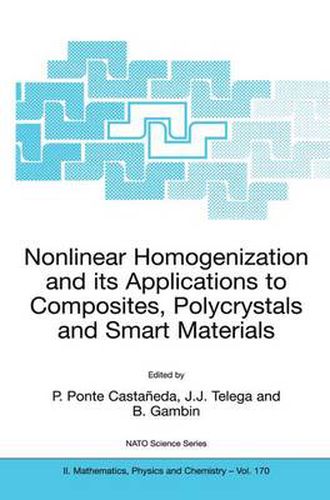Readings Newsletter
Become a Readings Member to make your shopping experience even easier.
Sign in or sign up for free!
You’re not far away from qualifying for FREE standard shipping within Australia
You’ve qualified for FREE standard shipping within Australia
The cart is loading…






This title is printed to order. This book may have been self-published. If so, we cannot guarantee the quality of the content. In the main most books will have gone through the editing process however some may not. We therefore suggest that you be aware of this before ordering this book. If in doubt check either the author or publisher’s details as we are unable to accept any returns unless they are faulty. Please contact us if you have any questions.
Although several books and conference proceedings have already appeared dealing with either the mathematical aspects or applications of homogenization theory, there seems to be no comprehensive volume dealing with both aspects. The present volume is meant to fill this gap, at least partially, and deals with recent developments in nonlinear homogenization emphasizing applications of current interest. It contains thirteen key lectures presented at the NATO Advanced Workshop on Nonlinear Homogenization and Its Applications to Composites, Polycrystals and Smart Materials. The list of thirty one contributed papers is also appended.
The key lectures cover both fundamental, mathematical aspects of homogenization, including nonconvex and stochastic problems, as well as several applications in micromechanics, thin films, smart materials, and structural and topology optimization. One lecture deals with a topic important for nanomaterials: the passage from discrete to continuum problems by using nonlinear homogenization methods. Some papers reveal the role of parameterized or Young measures in description of microstructures and in optimal design. Other papers deal with recently developed methods - both analytical and computational - for estimating the effective behavior and field fluctuations in composites and polycrystals with nonlinear constitutive behavior.
All in all, the volume offers a cross-section of current activity in nonlinear homogenization including a broad range of physical and engineering applications. The careful reader will be able to identify challenging open problems in this still evolving field. For instance, there is the need to improve bounding techniques for nonconvex problems, as well as for solving geometrically nonlinear optimum shape-design problems, using relaxation and homogenization methods.
$9.00 standard shipping within Australia
FREE standard shipping within Australia for orders over $100.00
Express & International shipping calculated at checkout
This title is printed to order. This book may have been self-published. If so, we cannot guarantee the quality of the content. In the main most books will have gone through the editing process however some may not. We therefore suggest that you be aware of this before ordering this book. If in doubt check either the author or publisher’s details as we are unable to accept any returns unless they are faulty. Please contact us if you have any questions.
Although several books and conference proceedings have already appeared dealing with either the mathematical aspects or applications of homogenization theory, there seems to be no comprehensive volume dealing with both aspects. The present volume is meant to fill this gap, at least partially, and deals with recent developments in nonlinear homogenization emphasizing applications of current interest. It contains thirteen key lectures presented at the NATO Advanced Workshop on Nonlinear Homogenization and Its Applications to Composites, Polycrystals and Smart Materials. The list of thirty one contributed papers is also appended.
The key lectures cover both fundamental, mathematical aspects of homogenization, including nonconvex and stochastic problems, as well as several applications in micromechanics, thin films, smart materials, and structural and topology optimization. One lecture deals with a topic important for nanomaterials: the passage from discrete to continuum problems by using nonlinear homogenization methods. Some papers reveal the role of parameterized or Young measures in description of microstructures and in optimal design. Other papers deal with recently developed methods - both analytical and computational - for estimating the effective behavior and field fluctuations in composites and polycrystals with nonlinear constitutive behavior.
All in all, the volume offers a cross-section of current activity in nonlinear homogenization including a broad range of physical and engineering applications. The careful reader will be able to identify challenging open problems in this still evolving field. For instance, there is the need to improve bounding techniques for nonconvex problems, as well as for solving geometrically nonlinear optimum shape-design problems, using relaxation and homogenization methods.